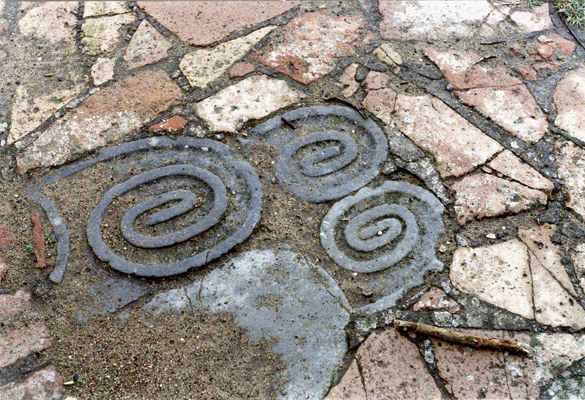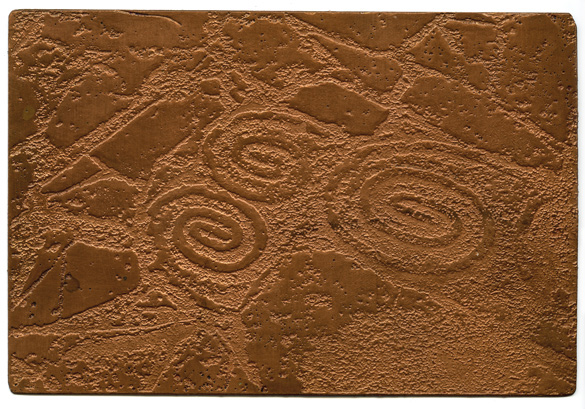San Severa’s Pinwheels

from photo

to copperplate, deep etched

to print
Recently I was rummaging through some of my old etched copperplates and came across this old favourite (centre image). That sent me looking for the few remaining prints that I still have from the edition. I had neglected to document it in my book as it was one of those small prints I would very occasionally make for print sales and for gifts so I had to search in old sketchbooks to recall when I’d made these. It was in the late 90’s during the period I was working on the Paths series.
This sent me on another path to the photo album of our trip to Italy in the fall of 1993 to find the original photo from which the image was created. It was taken on the grounds of an interesting and inspiring Etruscan castle we came across quite serendipitously, San Severa on the west coast north of Rome.
So, I thought some of my curious dear readers might enjoy seeing how a photograph ended up as an etching. If you are interested in a bit more technical information on the process of transferring the image to the plate, please visit this note. When the plate was ready, I inked it in the intaglio and relief method. The dark red-brown ink was rubbed into the deeply etched areas and top face or relief was wiped clean. Then with a hard roller the blue-green colour was rolled on the relief areas. Finally it was hand printed on an etching press onto paper.
November 15, 2011 in Paths, Printmaking, Printworks by Marja-Leena
fascinating to know more of the process. especially the etruscan castle grounds bit! x
Elisa, glad you think so. I wish I could get a better image of the print here, it’s not quite this dull but MT seems to insist on it.
Yes. My mind goes over the swirls and lines and my thoughts are blazing like newly shined copper. Nice, Marja-Leena! I would love to run my fingertips over the copperplate.
I would love to find that in a pavement. There are some, new, versions of this in the older sections of Boston, art beneath one’s feet.
Reminds me of the Stolpersteine project.
Rouchswalwe, thanks, I’m glad you enjoyed this.
Zhoen, yes, wouldn’t it be great to have more art like this beneath our feet? I had not known of the Stolpersteine project.
Funny how years later in London, I was similarly captivated by the many interesting utility covers, not quite as interesting as this of course, but which led me to my London Underfoot prints (see the ARKEO series).
So interesting. I love these colours. At present in the printing class we are exploring inking in the way you describe, and I do enjoy not having to clean up between colours!
I also enjoyed looking at your Paths prints again.
Olga, this would certainly be of more interest now that you are doing printmaking. It’s been quite a while since I’ve done any etching so it’s interesting for me too to revisit my old work. The Paths series came forth at the time when our studio darkroom was eliminated and we moved to digital processes for preparing the film positives for photo-etching plates.
sometimes i have trouble with the intensity of a colour – my raspberry posts were turning out very dull. i haven’t had a problem since them, but we solved it by doubling the images layers and turning the top one to ‘screen’… just to make it look right online. worth a try?
Elisa, I tried your suggestion but it became even more washed out and pale. I made many adjustments on the original scan in PhotoShop until it looked as close as possible to the print but MovableType just keeps making the reduced jpg version dull, must be the particular colours. Ah well, I’m not going to fuss with it anymore, but thanks!
Very interesting. I love seeing an artist’s process. And I like looking at the ground also–particularly around old castles!
When he came back from Europe, James Fenimore Cooper had a tile floor put down around the altar at Christ Church in Cooperstown, and I am always dying to crawl around and get every little detail of the images and words. There’s one that appears several times with a tower and swan and words. Must get down to ant level! Then there is a large area that spells out Exultemus in Nomine in a rectangle, also made of small tiles. I have a huge desire to know what the little ones all say and mean, but the words are so small.
Marly, another ground-looker! That church floor sounds very very interesting. You need to get down on your knees with a good camera, maybe even a macro lens to get those tiny words. Now there’s another project!
It looks pretty wonderful to me. I haven’t seen the original of course, but I like the shapes and colors a lot.
Hattie, thank you!
I don’t know why I didn’t know (except for the fact I never studied printing) that you could do copper plate etchings from photographs. I read your note about the process and found it fascinating. The results of this one are wonderful.
Susan, thanks. Photo-etchings can be made using zinc plates as well but I always Ioved working with copper the most, though it is more expensive. I was very happy to not have to use the darkroom anymore when the new digital processes came along, though that meant a steep learning curve for a while.